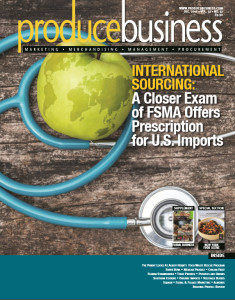by Amy Myrdal Miller
 NOTE: This article originally appeared in the December 2016 issue of Produce Business magazine.
NOTE: This article originally appeared in the December 2016 issue of Produce Business magazine.
I was interviewed recently for an article on opportunities to use more fruits and vegetables in desserts in restaurants. Using more fruit is easy. Using more vegetables is easier said than done.
First, we have to examine our expectations for desserts. Desserts are typically sweet. Using fragrant, ripe fruit in desserts meets the belief that desserts must be sweet. Using vegetables takes a bit more skill and finesse to develop a dessert that delivers on expectations of sweetness, texture, and appearance.
National dietary intake data from the “What We Eat in America” survey shows that grain-based desserts account for a larger proportion of daily calories than any other food group for people age 2 and older. So even though diners may say no to dessert in restaurants, many of us enjoy cakes, cookies, cobblers, sweet rolls, pastries, donuts and other baked goods on a frequent basis. There are many opportunities to improve the nutrient profile of these foods.
But improving the nutrient content doesn’t always drive demand. (Are you laughing at the irony of that statement?) Are there ways pastry chefs can incorporate vegetables into the grain-based desserts we love that will make us love them even more?
There are already many classic desserts that feature vegetables, including Pumpkin Pie, Sweet Potato Pie, Sweet Corn Cake, Rhubarb Pie, and Carrot Cake. What about using beets to color Red Velvet Cake? With demands for clean labels, using a natural ingredient like beets to color cake instead of artificial colors is a good decision. This idea isn’t that new. General Mills uses beet extract to color some of the new Trix with no artificial colors or flavors. If it works in a sweet cereal, it can work in a dessert.
Another trend no one can escape during the fall months is pumpkin flavored everything. From lattes and donuts to cream cheese and crackers, pumpkin flavor appears in hundreds of new products at retail every fall. But many ask where’s the pumpkin? Instead of using pumpkin flavor or the sweet spices associated with pumpkin flavor to trick the brain into thinking “Gee, this tastes like pumpkin!”, product developers and pastry chefs can use more pumpkin, squash, or sweet potatoes in desserts like ice cream, cake, panna cotta or crème brûlée.
Carrots are another vegetable that can stand in for pumpkin in many recipes, especially if ginger is used as a spice or fresh ingredient. Imagine a ginger-spiced carrot pudding with ginger snaps for dipping.
If we shift our thinking from culinary use to botanical classifications, we can see that items like cucumbers can be used in place of their melon cousins. On a hot summer day, a cucumber mint sorbet is a refreshing and approachable lighter finish to a meal.
One issue every pastry chef in America will need to pay attention to in the coming year is added sugar. Sugar is the new fat in terms of consumer sentiment. Right now, dietary surveys show Americans consumer from 13-16% of calories from added sugar. The 2015-2020 Dietary Guidelines for Americans recommend getting no more than 10% of calories from added sugar. The nutrition and public health community is looking for ways to reduce added sugars while also promoting the enjoyment of our food.
Awareness of added sugar will be fueled by the new Nutrition Facts panels we’ll be seeing on retail products. The new panel includes a line for added sugar. The old panels include total sugars, which includes both naturally occurring and added sugars in products.
Per the FDA, added sugars include brown sugar, cane syrup, coconut sugar, corn sweetener, corn syrup, dextrose, fructose, fruit juice concentrates, glucose, high-fructose corn syrup, honey, invert sugar, lactose, maltose, malt sugar, molasses, raw sugar, turbinado sugar, trehalose, and sucrose or table sugar.
A pastry chef who is thinking about ways to reduce added sugars in desserts may want to consider the sweetening power of ripe fruit as well as roasted vegetables, like roasted sweet potatoes or carrots.
So, can we put more produce in desserts? Yes, absolutely! But like every product and menu R&D challenge, it takes some creativity along with strategy to get the flavor, appearance, texture, price point, and descriptive language just right. I’m up for the challenge. Are you?
Amy Myrdal Miller, MS, RDN, FAND is a farmer’s daughter from North Dakota, award-winning dietitian, culinary nutrition expert, known kale hater, and founder and president of Farmer’s Daughter Consulting, Inc. You can learn more about her business at www.farmersdaughterconsulting.com and you can follow her insights on food and flavor issues on Twitter @AmyMyrdalMiller

